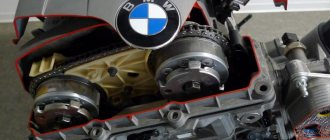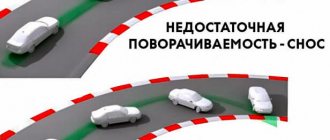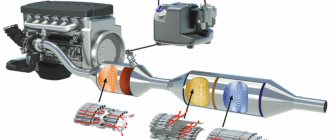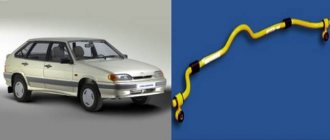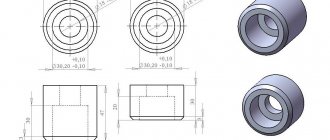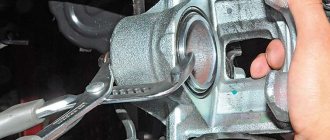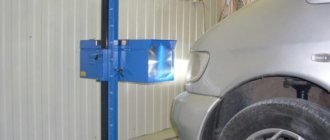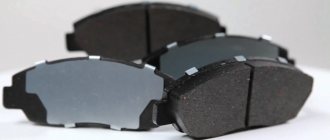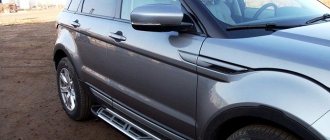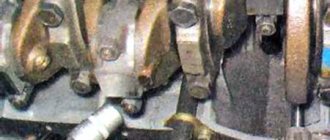Ask any experienced driver with extensive driving experience: why do you need a front strut brace? He will answer without much hesitation. But not every beginner has a complete idea of what it is all about. In addition, for most ordinary car enthusiasts, this element is just some kind of tube, usually yellow in color, nothing more. Some even find it a kind of highlight to show off in front of their friends.
And if you ask them why the front strut is needed, they either don’t know what to answer, or they begin to come up with a completely passable explanation from their point of view. Of course, from the outside it looks unprofessional, and such excuses have nothing to do with the actual purpose. And to understand why this yellow tube is needed, you will have to turn to the structure of the car body.
General overview
The body of any vehicle is assembled from many elements that are connected to each other by welding, bolts, rivets, etc., so if a certain load is applied, they gain some degree of freedom of movement in relation to each other. Most likely, anyone who has gone through extreme driving school knows this firsthand.
And the lower the degree of such freedom, the more integral the body becomes, approaching the state of a single whole. In other words, it becomes more rigid, and the higher this parameter, the better its control. This is especially felt when performing various maneuvers at high speed.
The essence of spacers
Now we are gradually approaching the most important thing - the pipe is not at all a way of self-expression in front of others. By and large, this is a technical modification of the vehicle; in another way, it can be called “tuning,” which is pleasant for many car enthusiasts.
A spacer (or guy) is a metal tube with a rectangular or square cross-section. Special platforms are welded to both sides for reliable fastening to a VAZ (“Ten”) car or any other brand.
These elements are usually located in the transverse direction of the engine compartment. The platforms are attached to the rack glasses with bolts from the supports. This allows you to minimize the displacement of parts of the car body relative to each other. In addition to the fact that the installed spacers improve the handling of the vehicle, they are able to take on part of the loads placed on the suspension elements. In turn, this helps to extend the life of the body.
As for cornering, a brace connects the front shock absorber cups into a single unit. As a result, their movement is limited, which gives additional rigidity to the car body.
Installation of the front strut
The spacer is installed using a simple algorithm:
- Park the machine on level ground.
- Unscrew the nuts on the “glass”.
- Put on a spacer. If the part fits the car model, it can be connected to the existing mounts without any problems.
- Install the washers under the spacer, and then put the part on.
- Screw and tighten the nuts. If the spacer is adjustable, adjust its position.
The benefits of the spacer are beyond doubt. At the same time, many car owners who are not ready to spend money on purchasing a device plan to make the part themselves. Theoretically, this is possible, but the process is very expensive and complicated. You need to find a welder and be able to work on a lathe. In addition, there are no guarantees of the reliability of a homemade device.
Another thing is to buy a ready-made part, which will cost a small amount and will exactly fit the existing fasteners. All that remains is to put it in place and tighten the fastenings tightly. But remember that installing a spacer also has a number of disadvantages. So when buying, you should think about whether you need such a modification or not.
Key Features
To summarize, here are some key points to better understand the role of spacers. When driving on a bad road (potholes, potholes, country roads), rolls, turns, strong loads act on the car body, which deform it. This negatively affects the vehicle's handling, which ultimately leads to a reduction in its service life. And there are reasons for this:
- The weaker the rigidity of the body, the more it will “twist” when entering turns or hitting bumps.
- Metal tends to “get tired” over time, which is why cracks appear in the load-bearing elements.
- The constant impacts that fall on the wheels are also transmitted to the side members of the body. Over time, they begin to bend inward, which can lead to the fact that at one point it will become impossible to adjust the camber of the front wheels.
As a rule, in cars (for example, VAZ “tens”) that have been used in difficult conditions for more than 10 years, the side members are already quite severely deformed.
In this case, it is necessary to use a special stand to stretch them, only after that it is possible, if not necessary, to install the stretch marks.
Purpose of the rear beam stabilizer
Suitable for installation on front-wheel drive models, placed on the rear beam. This helps to increase its angular rigidity. The tilt of the car is also reduced. When cornering, the tires will have better grip on the road surface. Another advantage is the even distribution of the load on the shock absorbers if one of the wheels runs over an uneven surface.
Life situations are different, and falling into holes is a common occurrence. You can hit the rear wheel so that it hangs out a lot. Even minor contact with an obstacle leads to the breaking of the shock absorber rod. Catching stones and bricks is a common thing. Reinforcing the beam with a stabilizer will help avoid such unpleasant moments. Extends the life of the shock absorber.
To summarize, we can recommend that those who are going to do something to think about their driving first. Do you really drive so aggressively that you have to suffer while driving? If everything is in order with the ride, it is calmer and more measured, you can continue to drive a production car.
Adjustable and non-adjustable stretchers
The non-adjustable spacer is a one-piece piece with no detachable connections. The peculiarity of adjustable stretch marks is that they consist of two units connected by a coupling. Due to this, it becomes possible to change the length of the spacer, making it smaller or larger depending on the need.
Many drivers prefer one-piece structures because they provide a higher degree of rigidity than their adjustable counterparts. However, there may be cases when it is impossible to select a one-piece design for a single vehicle. In this case, adjustable stretch marks are the only correct solution.
What other stretch marks are there?
In addition to non-adjustable and adjustable spacers, there are other types, it all depends on the attachment points of the spacer:
- Two-point - ordinary tubes that are attached to the shock absorber strut cups.
- Three-point – usually this design has the shape of a triangle. Such spacers are attached in the same way as two-point ones, but there is one more point for mounting on the body. Because of this, the rigidity is even higher.
The fact that the 3-point bracing gives a lot of extra rigidity to the body is definitely a plus. However, the large time investment required to install this type of structure is a clear disadvantage.
Improved dynamics
The spacer is made of high quality steel. It can improve body rigidity. In addition, handling improves. As experienced mechanics say, the spacer bar prevents microdeformation of the body. If anyone doesn’t know, it occurs when cornering, and this also causes increased tire wear.
Today, the automobile market is overflowing with different options. They are both universal and for a specific car model. Manufacturers are also different, from well-known world brands to small Chinese companies. When purchasing a part, try not to skimp on it. Choose something average in price, so you can find a middle ground between quality and price.
Clear benefits
Car body struts have both their advantages and disadvantages. But perhaps it’s worth starting with something pleasant. The obvious advantages include:
- Due to the increased rigidity of the body, the vehicle corners better.
- Improved car handling is manifested in the fact that it becomes more confident on the road.
- The trajectory when cornering is more precise and clear.
- Less likelihood of age-related cracks appearing on the body.
- Increased machine stability during straight-line movement.
- No deformation when driving over road irregularities.
With regard to cars with high mileage and at least a shorter service life (15 years or more), one thing can be said: after the procedure of retracting the side members (and with such a long history it is necessary to do this in any case), it is recommended to install stretch marks. This is due to the previously mentioned reason – metal “fatigue”. Without proper reinforcement, the car body can quickly become unusable.
Pros and cons of spacers
Many drivers who installed spacers either with their own hands or in specialized workshops note the following advantages:
- When cornering, you especially feel stability and ease of control.
- Body vibration is significantly reduced.
- Increases driving stability on a flat road.
- The risk of cracks in the metal is reduced.
Another advantage of stretch marks is the ease of installation. You just need to tighten the bolts and nuts well.
Disadvantages of spacers:
- A rigid coupling does not dampen vibration. If without a brace each part of the body bends separately from each other, then with a brace one strong deformation on the side transfers the force to the other side.
- The spacer pipe may interfere with diagnostic and repair work on the engine.
Spacers are inexpensive. The cheapest is around 1 thousand rubles.
A number of disadvantages
Unfortunately, there are also some drawbacks, and now let’s look at a number of disadvantages. All extreme driving school graduates are well aware of them. The negative sides are:
- Under the influence of the load on one wheel, the second one is also affected. Fortunately, modern designs have special notches that allow the part itself to bend, leaving the other wheel intact.
- Some drivers note that after installing the spacers, both struts are damaged. This drawback is quite controversial, but it is still worth considering this possibility.
- Due to stretching on some car models, it may be difficult to change the brake fluid.
- In the event of an emergency or an impact on only one side, the entire front part of the vehicle body is affected.
A natural question may arise: why, for example, are there no front strut struts on the VAZ-2110 from the factory? This is not done for reasons of economy, as it might seem at first glance. It's all about the need to improve the safety of the driver and passengers, because the cars are designed for the mass market.
In addition, studies have shown that cars with stretch marks receive much more serious damage than vehicles without them. We can conclude that in the first case the driver and his passengers are in greater danger.
Varieties
Most often, 2 types of spacers are used for tuning - adjustable and non-adjustable. In practice, it turned out that a spacer with a control mechanism is worse than without it because it consists of 2 parts. Such a spacer will not bring much benefit after installation and will not achieve the desired success.
There are also differences in fastenings. The most commonly used spacers are 2-hole and 3-hole spacers for installation. The hardware with 3 mounting points will last the longest, but to install it, sometimes it is necessary to drill holes in the body. It is also worth noting that its installation is more complicated.
Non-adjustable strut extensions are mainly made for a specific car model. Adjustable ones are most often universal; they can be installed in any car, even if the holes do not fit.
Spacers also differ in the manufacturing method. Some of them are made from solid material using hot stamping technology. There are also spacers consisting of previously manufactured parts that are connected by welding. The first option is more reliable, but the second can also bring a lot of benefits after installation, increasing the rigidity of the body.
Some car owners increase the rigidity of the body by installing rear strut struts, but this option is not common, since the part reduces the free space in the trunk, which is often not enough.
Driving on uneven or dirt roads
In addition to the above advantages, it is worth considering the behavior of the car when driving on uneven roads, as well as when cornering. Let's start with the peculiarities of moving on uneven terrain: in this case, the wheels are constantly subjected to heavy loads.
Here is another argument for those who doubt the question of why the front strut strut is needed: as the speed of the vehicle increases, the impact force will also increase. Because of this, the lower suspension arms suffer, which can lead to their deformation. Thanks to the installed spacer, shocks are absorbed by it. As a result, part of the load is removed from the main suspension elements, which helps protect them from harmful effects.
Entering a turn
What happens to a car when it turns? Most of the weight of the body is transferred to the side opposite to the turn; excessive roll occurs, which can lead the vehicle away from the given trajectory.
Usually the anti-roll bar should combat this. And yet, why do you need a front strut strut, if there is a stabilizer, which is equipped with all cars without exception. The fact is that such an important part is not always able to withstand lateral loads. With the front struts stretched, it is noticeably easier for the stabilizer to perform its functions.
Let's give an example: if earlier, before the car went through a turn, it was necessary to reduce the speed to 60 km/h each time, then with installed stretch marks this parameter can be safely increased to 80 km/h.
Spacer Installation Procedure
To install spacers, it is not necessary to contact specialized service centers. You can do all the work yourself, except if necessary, enlist the support of loved ones. If the vehicle owner does not have the slightest idea about struts and braces, then it is better to visit the nearest service station to install front strut struts.
But if you have confidence in your abilities, then the following algorithm of actions will be useful:
- Place the car on a flat surface.
- Unscrew the nuts from both shock absorber strut cups.
- Washers are installed on the studs or bolts.
- The spacer is put on - the part suitable for the car will fall into place without any effort.
- Tighten and tighten the nuts. If the installed stretcher is of an adjustable type, its position should be adjusted.
There should no longer be any doubt about why the front strut strut is needed, and there is no doubt about the benefits of such an element. At the same time, most car enthusiasts are not ready to donate their funds to purchase factory blanks, preferring to make such a part themselves.
From a theoretical point of view, this is feasible, but it should be understood that the process is no less expensive and complex. This requires skills in working with a lathe and experience as a welder, but who can guarantee the quality of a homemade design?!
Spacers and braces
Very often, looking under the hood of a tuned car, we see, in addition to the modified engine, an incomprehensible stick that connects the front pillars to each other. Fashionable spec or unnecessary show off?
For a long time I had the idea in my head that this tuning would be applicable to a collective farm, but when I started digging deeper, I realized that this was not just a piece of hardware for decorating the engine compartment. It also has practical applications...
So why all these struts and body extensions?
Let's start in order...
The car body is not entirely cast, but consists of individual elements. Some elements are welded to each other, some are screwed... Whatever one may say, the body has “weak spots” in the places where they are attached. When driving, microdeformations of the body occur, which is why over time the car begins to lose stability on the road. When driving in a straight line, this is hardly noticeable, so this is not relevant for drag racing, but when changing lanes at high speeds (ring), the car is poorly controlled.
I don’t want to talk about bad things, but the car can be driven so strongly that you can lose control of the car and put your life in danger. That is why the first thing we see on the car is the front strut brace . It limits body deformation during torsion. It is this indicator that is very important when it comes to accurately and confidently changing lanes and taking turns at high speeds.
When installed on the front pillars, the spacer should fit freely onto the studs of the upper supports of the pillars (on the cups). To do this, you need to unscrew all visible nuts on the glass, but following certain rules. First of all, you need to park the car on a level area without slopes. If the car is level and the spacer is designed specifically for your car, then everything will fit without any hemorrhoids (don’t forget to leave the washers under the spacer), work for 5-10 minutes. If the holes do not fit onto the studs and the discrepancy is only 1-2 mm, then it is necessary to pull the car body in the right direction. Otherwise, an adjustable spacer is needed.
We put it on, tighten all the nuts, admire it and go test it on the track.
In my opinion, the adjustable front strut tower brace is not it. Of course, it will give rigidity to the body, but not that which a solid brace will provide.
There is a myth that the front strut brace during a frontal impact prevents the engine from moving into the car interior... I have never found confirmation of this legend on the Internet (((
Spacers are available as 2-point or 3-point:
- 2-point spacer is attached to the glasses;
- A 3-point brace is installed on the glasses + attached to the body, which forces additional holes to be made in the car body to securely fix it.
Unfortunately, I don’t know the fundamental differences. If I find it, I'll share it.
Spacers are installed not only on the front pillars, but also on the rear ones... And much more. Look at the picture below:
I also found several animated images that clearly show how the car behaves in certain conditions, with and without a spacer:
Front strut and lower control arm brace:
| Before: Part of the impact is transferred to the chassis, causing the base of the wheels and the lower part of the control arms to deform. | |
| After: By using A-pillar and lower control arm braces, both sides of the shock will be absorbed. |
Front strut and lower control arm strut (when turning):
| Before: Weight transfer and forces are concentrated on one side, resulting in drift and increased body roll. | |
| After: The force is distributed through the braces, the struts and lower control arms are stabilized, which ensures confident control of the car. |
Anti-roll bar:
| Before: When turning, weight transfer will make the vehicle less stable, causing body roll and making it difficult for the vehicle to return to the desired path. | |
| After: A car with an anti-roll bar will more effectively absorb the vehicle's inertial force when cornering, significantly reduce body roll, and provide high cornering stability. |
Side lower struts of the car body:
| Before: On uneven/bumpy roads, the chassis will have different levels relative to the center of the vehicle due to the weight transfer between the front and rear axle. | |
| After: A car with side lower body braces stabilizes the weight transfer between the front and rear axle, it can also minimize side impact damage. |
Wing strut:
| Before: The connection between the strut and the front chassis is subject to drag forces, causing damage to the chassis. | |
| After: The fender brace distributes the forces and strengthens the vehicle's body, which extends the life of the chassis and ensures stable handling of the vehicle. Recommended for sports cars. |
Examples of using spacers on a Honda Civic in an EK body:
Many are skeptical about struts and say that in the event of an accident, for example, in the front fender, not one strut is deformed, but two, precisely because of the stretching of the front struts. But excuse me, are you buying a car to beat it? If yes, then forget everything written in this post. This post is definitely not for you.
I will be very glad to add additions and comments.
Thank you.
PS Do not consider this post as an advertisement for Ultra Racing. It’s just that, unlike other manufacturers, they took care of the end user and made a clear manual for them. Z.Y. I would be very grateful if you could share a link to this post somewhere, because... in my opinion, this is the most complete and detailed post about car body struts and their work on the RU'net. Thank you.
Did you like the post? Here's the subscription: and | Help your dream come true
